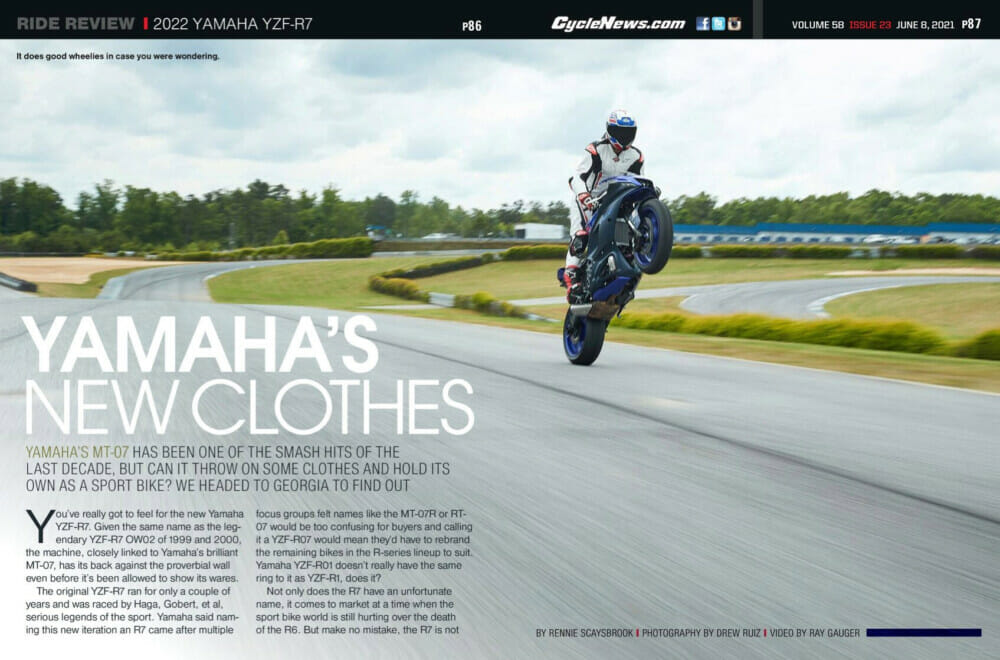Rennie Scaysbrook | June 9, 2021
Yamaha’s MT-07 has been one of the smash hits of the last decade, but can it throw on some clothes and hold its own as a sportbike? We headed to Georgia to find out.
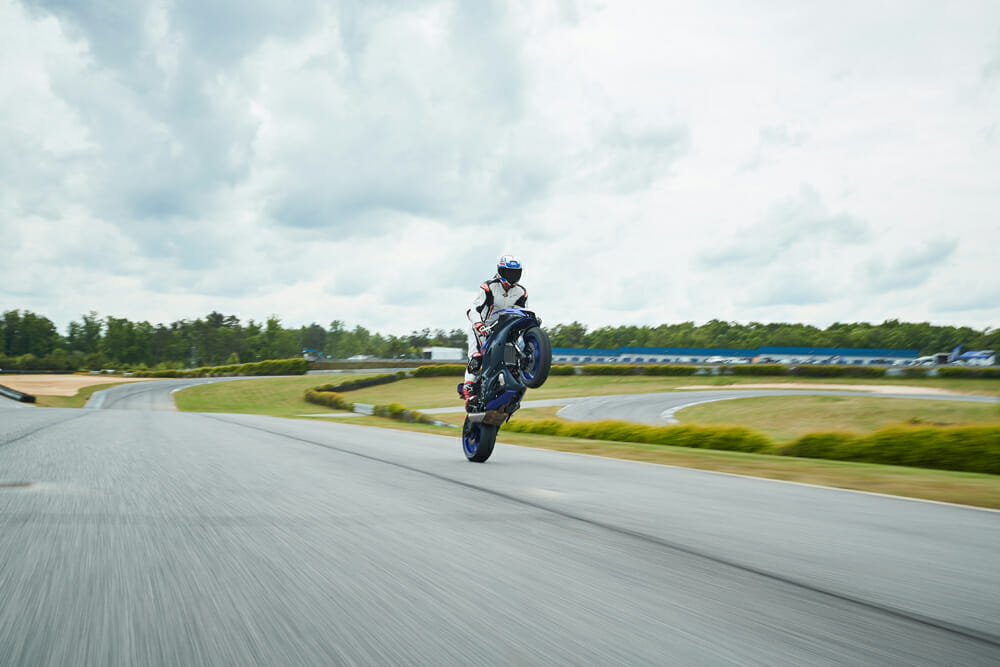 It does good wheelies, in case you were wondering.
It does good wheelies, in case you were wondering.
Photography by Drew Ruiz
You’ve really got to feel for the new Yamaha YZF-R7. Given the same name as the legendary YZF-R7 OW02 of 1999 and 2000, the machine, closely linked to Yamaha’s brilliant MT-07, has its back against the proverbial wall even before it’s been allowed to show its wares.
The original YZF-R7 ran for only a couple of years and was raced by Haga, Gobert, et al, serious legends of the sport. Yamaha said naming this new iteration an R7 came after multiple focus groups felt names like the MT-07R or RT-07 would be too confusing for buyers and calling it a YZF-R07 would mean they’d have to rebrand the remaining bikes in the R-series lineup to suit. Yamaha YZF-R01 doesn’t really have the same ring to it as YZF-R1, does it?
Not only does the R7 have an unfortunate name, it comes to market at a time when the sportbike world is still hurting over the death of the R6. But make no mistake, the R7 is not the replacement to the dearly departed R6. An R6 would annihilate an R7 in every conceivable performance department, but the new R7’s mantra is to be all things to all sportbike riders. Easier to live with, easier to ride to work, easier to ride on track. Easier all round.
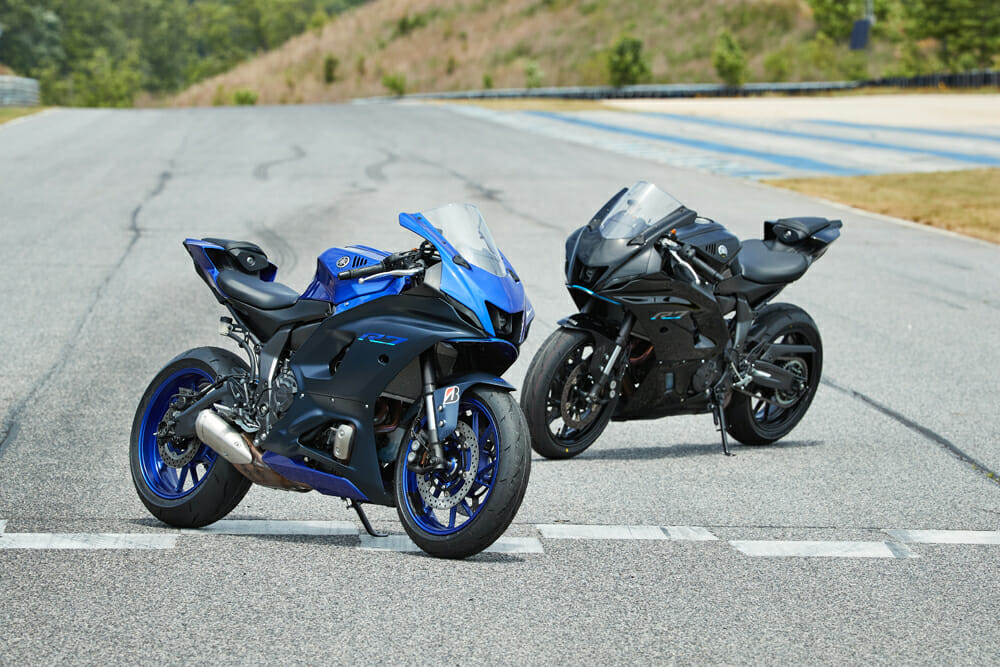 Yamaha’s hoping to leave the competition black and blue with the new R7. Oh, man, that was bad, even for us.
Yamaha’s hoping to leave the competition black and blue with the new R7. Oh, man, that was bad, even for us.
The $8999 2022 Yamaha YZF-R7 thus represents a new era for Yamaha’s sportbikes. Not to put too fine a point on it, but the R7 is basically an MT-07 in drag. Wrapped in very R6-esque bodywork that houses the fantastic looking LED headlights on either side and inside the intake, the R7 runs the same 689cc parallel-twin CP2 motor, and the same six-speed gearbox (although it does come with an assist and slipper clutch the MT-07 lacks). It also utilizes the same steel frame design with a few mods like a 5mm shorter wheelbase, 10mm less ground clearance, 0.7° steeper steering geometry at 23.7°, and 2mm less trail.
The swingarm is the same unit as on the MT, but the rear wheel sits a little further back thanks to a one-tooth-smaller rear sprocket that makes the gearing a little taller for racetrack/sporty speeds. Couple this with a different rear suspension linkage on the R7 and you’ve got a much better setup ready for the track.
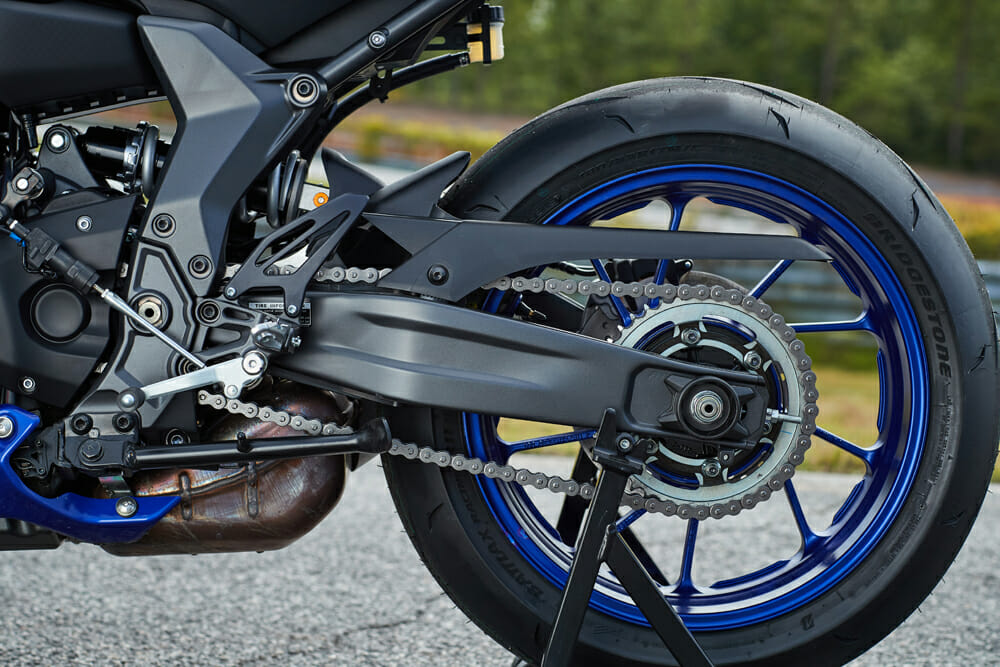 The swingarm is the same as the MT but geometry changes happen due to the smaller rear sprocket and different shock linkage which raises the back end a bit.
The swingarm is the same as the MT but geometry changes happen due to the smaller rear sprocket and different shock linkage which raises the back end a bit.
The R7 also runs fully adjustable inverted 41mm KYB forks and a shock with preload and rebound damping adjustment. There’s also radial-mounted four-piston front brake calipers, compared to the conventionally mounted calipers on the MT.
ABS comes standard as you’d expect and you can’t turn it off, which is a shame as we got the ABS kicking in pretty heavily while on the run to turn one at the fabulous Atlanta Motorsports Park.
Compared to the R6, the rider triangle is a little more relaxed with the handlebars a touch higher up and closer to you. The footpegs are basically in the same position, and the angle of the seat is similar, too.
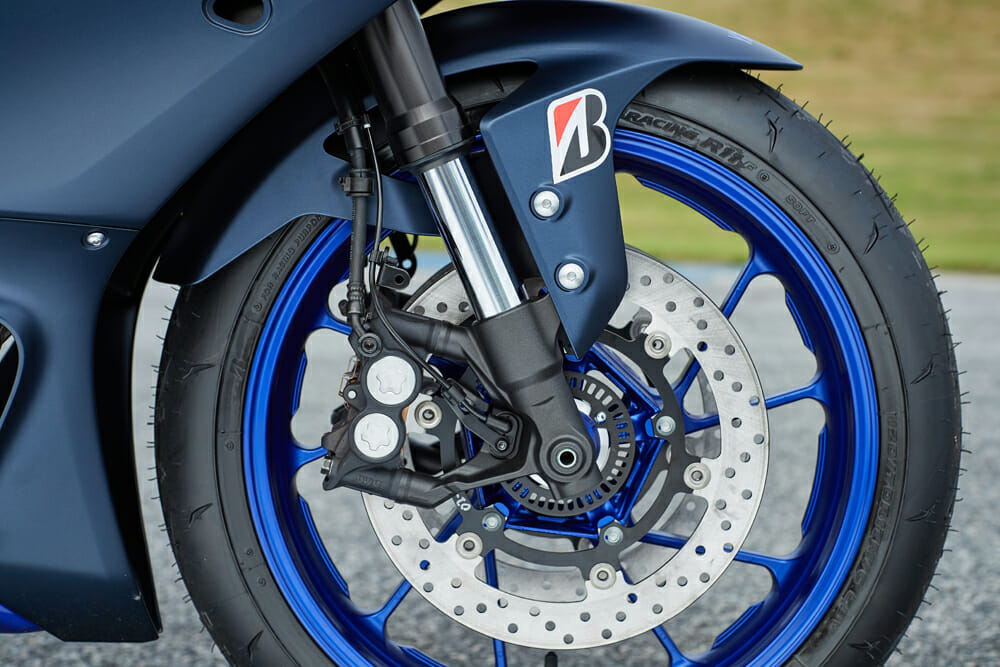 Advics brakes do the job well enough but don’t have a lot of feel.
Advics brakes do the job well enough but don’t have a lot of feel.
Where the R7 differs significantly is in the mid-section girth. With half the number of cylinders to deal with, the R7 is extremely skinny and is actually narrower across the top cowling than the R3, making it the most svelte sportbike in Yamaha’s lineup.
That tiny mid-section makes it very easy to put your feet down at a stop if you’re on the shorter side and makes it easier to tuck your knee against the tank when in a tuck and cornering.
Yamaha is claiming 414 pounds ready to ride with a full 3.7-gallon tank of gas for the R7, which puts it on the wrong side of the scale when talking about the bike everyone will compare this to in the $11,299 Aprilia RS 660 at 404 pounds.
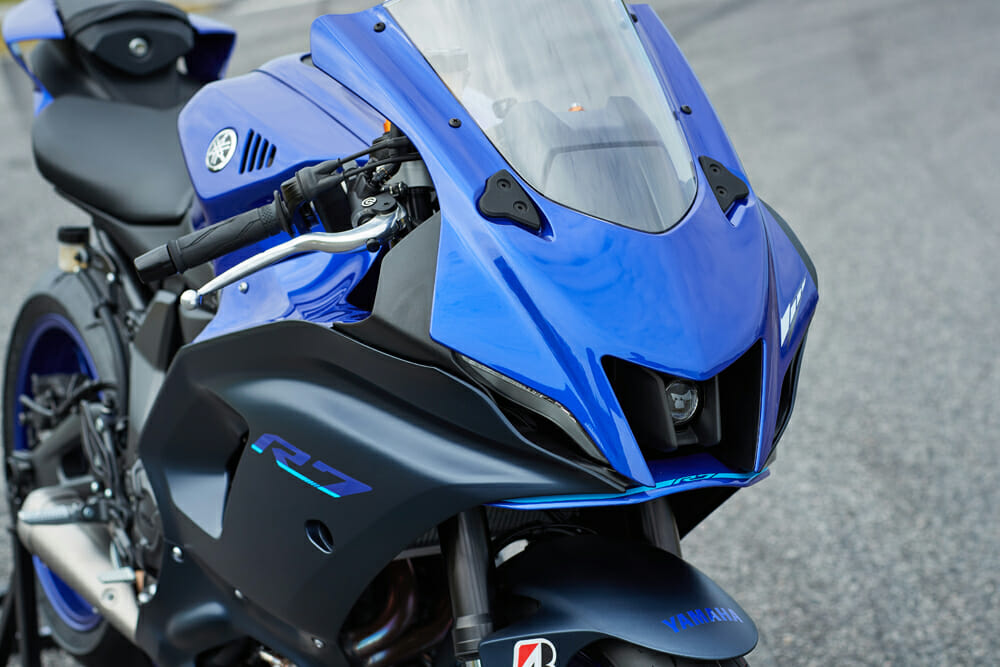 Yamaha has nestled the headlight in the intake, as well as on the sides of the nose fairing, and it looks spectacular.
Yamaha has nestled the headlight in the intake, as well as on the sides of the nose fairing, and it looks spectacular.
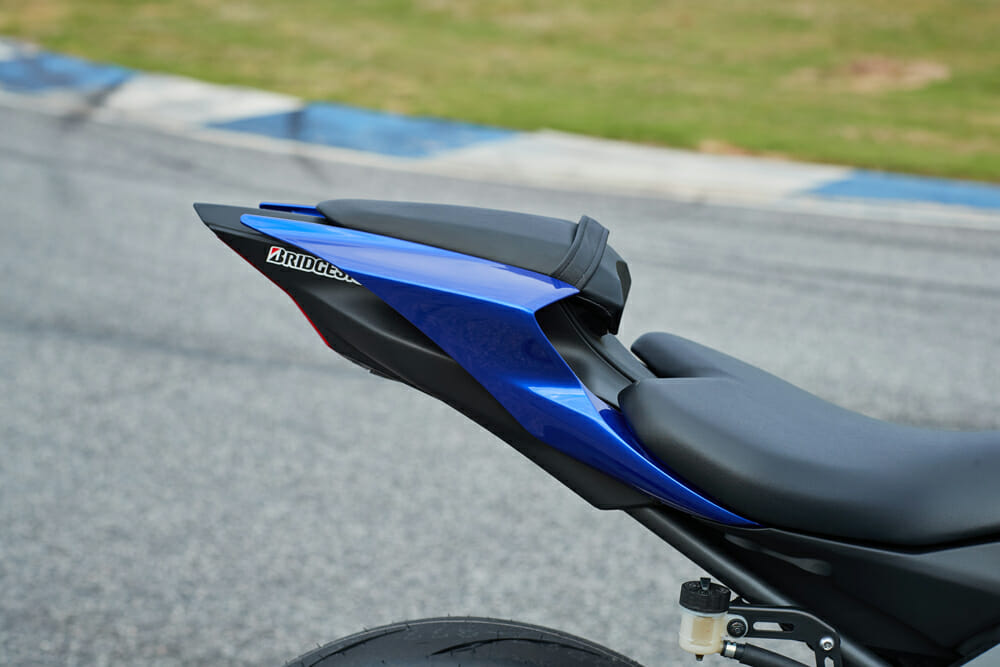 Look familiar at all?
Look familiar at all?
However, there’s a significant price difference between the two bikes, and I suspect Yamaha will probably sell five R7’s to every RS 660 Aprilia sells.
Our ride on the R7 saw us fly on our first packed plane since Covid to Georgia and the wonderful Atlanta Motorsports Park, a rich man’s paradise if ever there was one. The relatively tiny and very tight 1.8-mile venue came from the pen of famed Formula One track designer Hermann Tilke and is like a mini-Laguna Seca mixed with a sprinkling of Barber Motorsports Park and Sonoma Raceway. It was the perfect place for the Yamaha YZF-R7 to show it’s more than just a name.
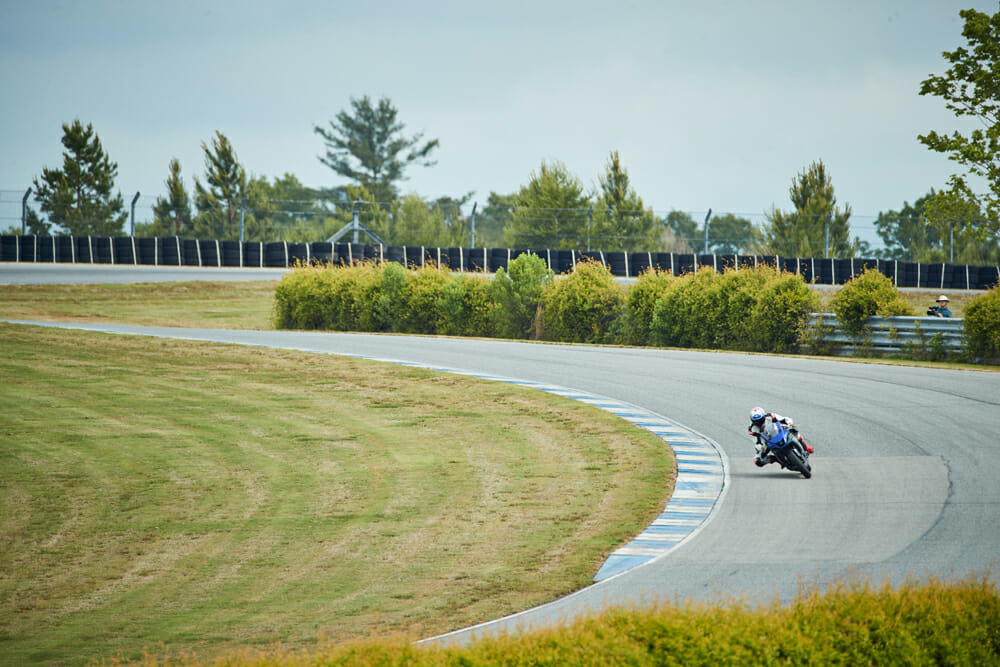 Atlanta Motorsports Park is a gem of a track and was recently voted one of the top 10 driving/riding tracks in the U.S. by our car colleagues at Road & Track.
Atlanta Motorsports Park is a gem of a track and was recently voted one of the top 10 driving/riding tracks in the U.S. by our car colleagues at Road & Track.
2022 Yamaha YZF-R7 Review | Track Time
At first when you hop on the R7, it’s impossible not to think of the outgoing R6. It looks so much like an R6 you must trick your brain into removing the old four-cylinder weapon from the thought process and accept the R7 for what it is. The second you do that, you’ll be much better for it.
A hint at the un-R6-ness of the R7 comes before you even start it. Once you take it off the side stand, the narrowness of the tank and seat does a great job to hide the fact the R7 weighs in at only a claimed six pounds lighter than the R6 did in 2020, its final year of production. But the overall weight is not the main story, it’s more that the lack of reciprocating mass when the engine is actually doing its thing makes the R7 so easy to turn, so light in the change of direction.
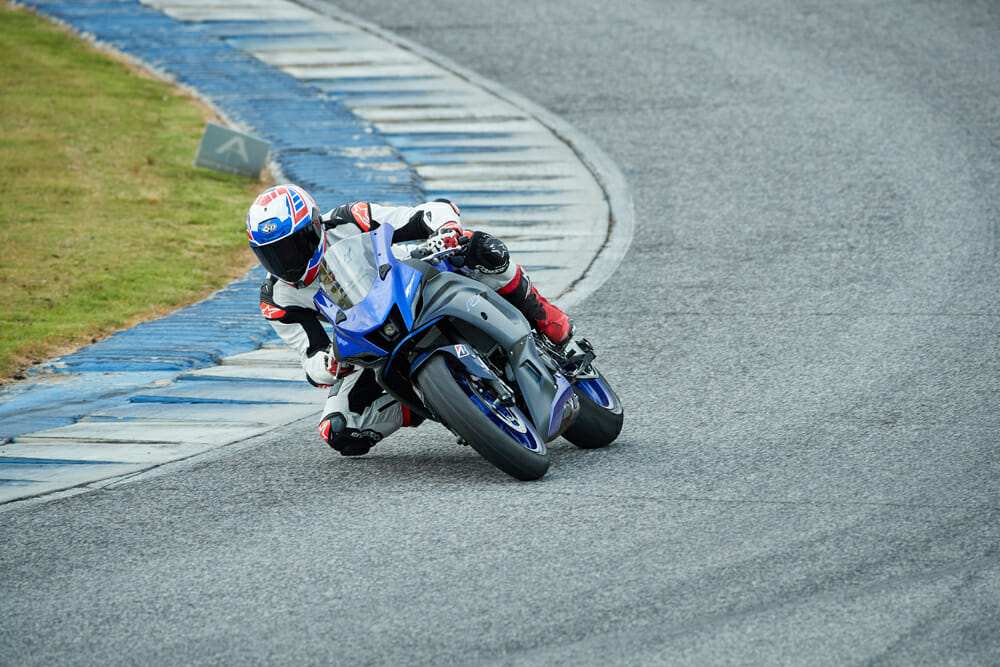 Anyone of any skill level will enjoy an R7. It will make an excellent tutoring bike.
Anyone of any skill level will enjoy an R7. It will make an excellent tutoring bike.
If you’re coming off a YZF-R3, the R7 will be a nice, easy transition in terms of power and low-end torque. If you’re coming from an R6 or bigger, it’ll feel slow. Be that as it may, the 689cc twin has lots of usable torque from the very bottom to the top of the rev range at 9500 rpm. There’s hardly a dip in drive as the little twin climbs the revs, but it’s best to get your shifts out of the way by 8500 rpm to keep it singing.
There are no electronics on the R7 aside from unswitchable ABS. No throttle maps, no TC, no adjustable engine brake, which is great because it just lets you get on with the job of riding. Our test bike had the $200 optional quickshifter fitted which lets you keep the throttle pinned for upshifts but does not provide auto-blipping on the downshift, so you’ve still got to go old-school with the clutch when heading back through the gearbox.
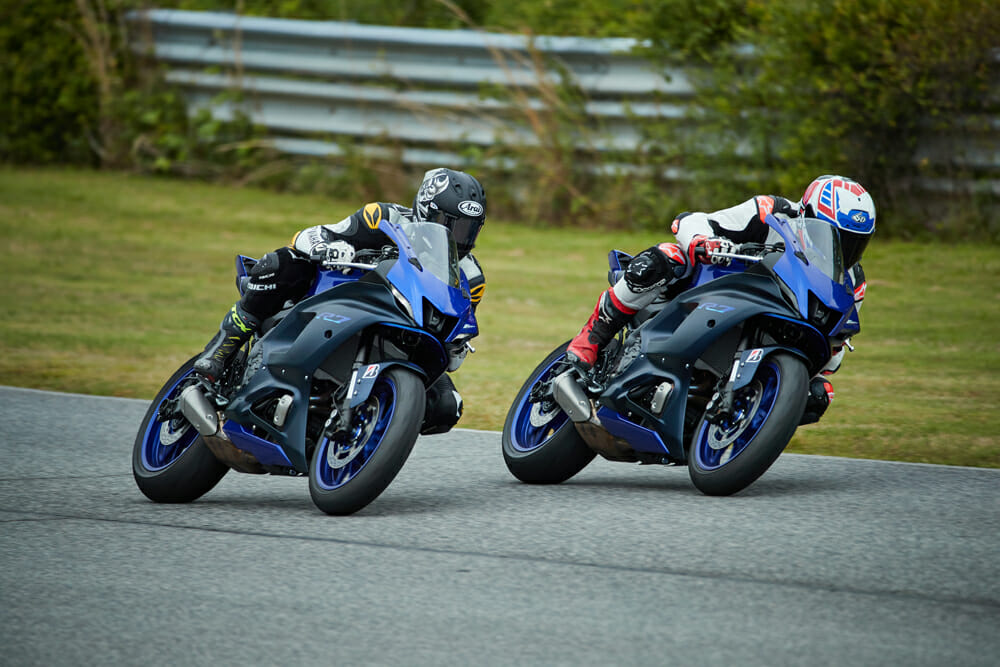 Rennie on the inside, Josh Hayes on the outside. The AMA legend was surprised how much fun he had on a bike with about a quarter of the power he’s used to.
Rennie on the inside, Josh Hayes on the outside. The AMA legend was surprised how much fun he had on a bike with about a quarter of the power he’s used to.
When doing so, you’ll doubtless be heaving on the brake power via Advics four-piston brakes, although the performance isn’t as good as I’d hoped for. It’s pretty easy to get the ABS pulsating on the track if you’re pushing hard, and the overall braking power leaves a little to be desired.
Off the brakes and tipping into the many blind crests of AMP, the R7 is so fluid it’s a sheer joy to ride. I’ve said a thousand times that riding a less powerful bike to its limits is more fun than being in the boxing ring with a heavyweight liter bike, and never is this more evident than in the twisty bits.
The R7 goes from upright to on its side quicker than you can blink, and it’ll change direction almost as fast. With a relatively rangy wheelbase of 55 inches, stability is never in doubt—the motor doesn’t really have the power to stress the chassis anyway, and you can wind the gas in super hard without the fear of the chassis kicking sideways and spitting you off.
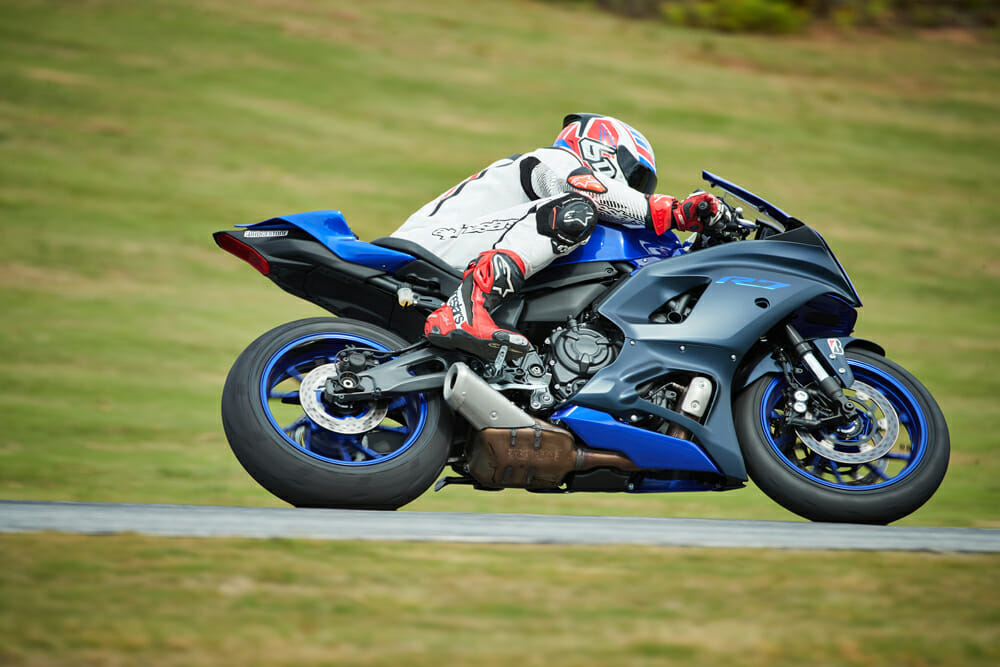 Yamaha has created the most unintimidating sportbike in the R7, although they’ve opened a can of worms as they now need to build an R9 to fill the gap to the R1.
Yamaha has created the most unintimidating sportbike in the R7, although they’ve opened a can of worms as they now need to build an R9 to fill the gap to the R1.
Where this bike will really be a hit on track is when places like the Yamaha Champions School get a fleet of them for their students. This is the perfect machine for teaching the basics of sportbike riding to a new or returning generation, the mix of a soft but compliant chassis setup and what can only be described as the friendliest motor in the middleweight class making for a lovely little track bike.
The softness of the front began to become a problem when myself, Michael Gilbert and Josh Hayes really started to push the R7s but up until that point the trade-off in compliance was worth it. Never did the R7 get out of shape—it was simply a great dance partner to have around the undulating Atlanta Motorsports Park.
The R7 is a bit like the son of a famous boxer, with neither the anger or single-minded purpose of his father, but still great fun to be with. It’s time to forget the naming issues, or the fact the R6 is no longer with us. The R7 is an excellent little bike that will appeal to a far broader reach of riders than the R6 ever could. If that gets people fired up to ride a sportbike, then Yamaha’s done its job nicely. CN
VIDEO | 2022 Yamaha YZF-R7 First Ride
Video by Ray Gauger
2022 Yamaha YZF-R7 Specifications
| MSRP: |
$8999 |
| Engine: |
4-stroke, inline twin-cylinder |
| Valvetrain: |
DOHC, 4-valves per cylinder |
| Displacement: |
689cc |
| Bore x Stroke: |
80 x 68.6mm |
| Compression Ratio: |
11.5:1 |
| Fuel System: |
Multipoint sequential electronic fuel injection |
| Exhaust: |
2-into-1 |
| Clutch: |
Wet, multi-plate |
| Transmission: |
6-speed |
| Frame: |
Die-cast steel |
| Front Suspension: |
41mm fork, USD, fully adjustable |
| Rear Suspension: |
Single shock, spring preload, rebound damping adj. |
| Front Tire: |
120/70 ZR17 in. |
| Rear Tire: |
180/55 ZR17 in. |
| Front Brake: |
Dual 298mm floating discs, 4-piston radial-mount calipers, ABS |
| Rear Brake: |
Single 245mm disc, 2-piston sliding caliper, ABS |
| Rake: |
23° |
| Trail: |
3.5 in. |
| Seat Height: |
32.9 in. |
| Wheelbase: |
54.9 in. |
| Weight (wet, claimed): |
414 lbs. |
| Fuel Capacity: |
3.4 gal. |
| Colors: |
Team Yamaha Blue, Performance Black |
